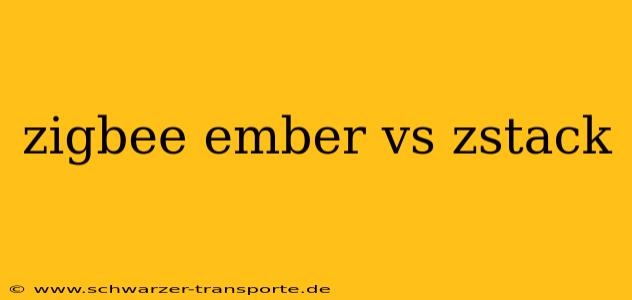Choosing the right network stack is crucial for any Zigbee-based project. Two dominant players in the Zigbee ecosystem are EmberZNet (now Silicon Labs' Ember) and Z-Stack, developed by Texas Instruments. This article delves into a detailed comparison of Ember and Z-Stack, helping you decide which best suits your needs.
Understanding the Landscape: Ember and Z-Stack
Both Ember and Z-Stack are Zigbee protocol stacks, providing the necessary software to implement Zigbee communication in your devices. They handle the complex details of network formation, routing, and data transmission, allowing developers to focus on the application logic. However, they differ significantly in their architecture, licensing, and features.
Ember (Silicon Labs)
EmberZNet, now marketed under the Silicon Labs brand, boasts a long history and a mature, robust ecosystem. Known for its developer-friendly tools and extensive documentation, Ember provides a comprehensive suite of features including:
- Simplicity: Ember is generally praised for its intuitive development environment and straightforward APIs. Developers often find it easier to learn and use than Z-Stack.
- Robustness: Ember's stability and reliability are highly regarded within the industry, minimizing unexpected issues and crashes.
- Comprehensive Tooling: Silicon Labs offers a powerful integrated development environment (IDE) with debugging tools, simplifying development significantly.
- Strong Community Support: A large and active community provides ample resources, tutorials, and assistance.
Z-Stack (Texas Instruments)
Z-Stack, developed by Texas Instruments, is another widely adopted Zigbee stack. It’s favored for its versatility and wide range of supported hardware platforms. Key characteristics include:
- Wide Hardware Support: Z-Stack boasts compatibility with a vast number of Texas Instruments microcontrollers, providing developers with greater hardware choices.
- Flexibility: Z-Stack often offers more customization options, allowing for fine-grained control over the Zigbee network behavior.
- Cost-Effectiveness: Z-Stack might sometimes offer more budget-friendly options for hardware and licensing, depending on the project's scale.
- Steeper Learning Curve: Compared to Ember, Z-Stack's complexity can present a steeper learning curve for beginners.
Key Differences: A Head-to-Head Comparison
| Feature | Ember (Silicon Labs) | Z-Stack (Texas Instruments) |
|---|---|---|
| Ease of Use | Generally easier to learn and use | Steeper learning curve, more complex configuration |
| Hardware Support | Primarily Silicon Labs chips, but some third-party | Primarily Texas Instruments chips, but some third-party |
| Documentation | Extensive and well-regarded | Comprehensive, but can be less user-friendly |
| Community Support | Large and active community | Active community, but potentially smaller than Ember's |
| Cost | Can be more expensive initially | Potentially lower initial cost, depending on hardware |
| Licensing | Proprietary licensing | Proprietary licensing |
| Debugging Tools | Excellent integrated debugging tools | Debugging tools available, but might require more setup |
Which Stack is Right for You?
The best choice depends on your project's specific requirements:
- Choose Ember if: You prioritize ease of use, robust tooling, and a large, supportive community. You're comfortable using Silicon Labs hardware or are willing to adapt. A strong focus on rapid development is key.
- Choose Z-Stack if: You require maximum hardware flexibility and are working with Texas Instruments microcontrollers. Customization and granular control over network parameters are vital. You're prepared for a steeper learning curve.
Beyond the Basics: Advanced Considerations
- Security: Both Ember and Z-Stack offer robust security features conforming to the Zigbee standard. Carefully review the security implementations within the specific version you select.
- Network Topology: Both support various network topologies, allowing you to tailor the network structure to your application.
- OTA Updates: Both support over-the-air (OTA) firmware updates, crucial for maintaining and upgrading deployed devices.
Conclusion: Making the Informed Decision
Selecting between Ember and Z-Stack requires careful consideration of your project needs, technical expertise, and budgetary constraints. While both are capable and well-regarded Zigbee stacks, their differences in ease of use, hardware support, and community resources make one a better fit than the other, depending on your specific context. Thoroughly research each platform before making a commitment, as the right choice will significantly impact the success of your Zigbee project.
